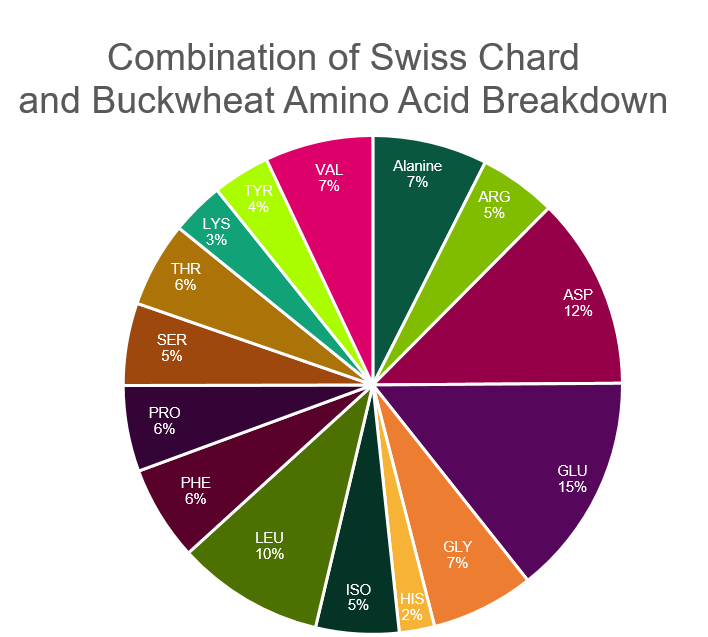Combining Two Super Crops: Buckwheat and Swiss Chard
Summary
The combination of two super crops, buckwheat and Swiss chard, yields a colorful variety of amino acids, macronutrients, and phytonutrients, with great health benefits.
What is the nutritional outcome when you combine Swiss chard and buckwheat? A colorful variety of amino acids, macronutrients, micronutrients, and phytonutrients.

Figure 1. Pie chart illustrating the amino acid breakdown in the combination of Swiss chard and buckwheat.
Buckwheat* is rich with iron (33 percent), magnesium (19 percent), manganese (13 percent), vitamin K (11 percent), potassium (7 percent), and a handful of other nutrients. Swiss chard* is also a great source of iron, magnesium, vitamin K, and potassium, and is also dense with selenium (18 percent).
Buckwheat and Swiss chard also share a couple of phytonutrients, including carotenoids (beta-carotene, lutein, zeaxanthin), chlorophyll, and flavonols (quercetin). Buckwheat also contains anthocyanidins, while Swiss chard is a great source of lignans and betalins.
Buckwheat and Swiss chard are also excellent sources of protein, with their total protein value coming in at 12.25 grams and 25.81 grams per 100 grams of dry extracted material, respectively.
Eating a diet packed with whole foods like buckwheat and Swiss chard provides a natural delivery system for nutrients in food to be absorbed in the body. Nutrients from whole foods are delivered in a natural matrix of protein, fat, and fiber – improving bioavailability and maximizing the “bang for your buck” with each meal.
Learn more about the whole food advantage in this animation.
Check out the “Color of Food” series, including a breakdown of nutrient and phytonutrient profiles for buckwheat and Swiss chard, here. This new set of resources is designed to improve understanding of the significance of phytonutrient and nutrient gaps, the GAE connection, the whole food advantage, and the role of specialty crops and the Farm Bill to provide the tools needed to make conscious decisions about our health and the health of the people around us.
*Per 5 grams of dry material




